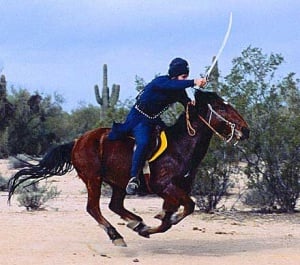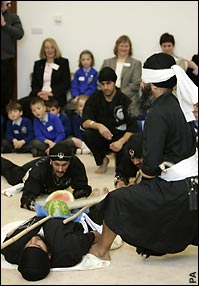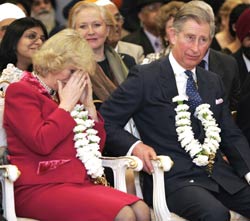Gatka
Gatka is an ancient martial art which has been thoroughly battle-tested and has existed in northern India for many thousands of years. Although it uses the sword as its primary weapon, many other weapons are available to the Gatka master. Today, this art exists exclusively amongst the Sikhs who have passed down the flamboyant techniques through generations, since their sixth Guru, Guru Hargobind wore the two swords of Miri and Piri.
The Sikhs have been responsible for the revival of this early art ensuring it's survival despite mass persecution of the native population in India by foreign invaders like the Mughals and others for many hundreds of years.
Gatka is a complete martial system which uses spiritual, mental and physical skills in equal portions to help one fully competent in defending themselves and others. It is a system that can only be used in defence as per:
| "When all other means have failed, it is proper to take the sword in one’s hand", |
In addition to giving the student defensive skills, it also helps the individual with other aspects of their life: makes the mind alert and responsive, maintains the body in a near perfect condition and makes soul fearless, compassionate and tranquil.
The techniques involved are extremely effective for defence and attack as well as visually spectacular. The Sikhs mastered Gatka and perfected its use in battle. Many battles were won by the Sikhs, despite almost always numbering far fewer than the opposite forces. The techniques within Gatka were combined with the spiritual practices of the Sikhs to create a perfect fighting system. Opposing forces have documented how awesome these Sikhs were at battle!
Gatka: The Sikh martial art form.
- 'Gatka is the traditional martial art of the Sikhs. It is based on the basic principle of unification of the mind, body and spirit in a rhythm of life to train a saint-soldier.
Legends
Gift from Rajputs
- According to one legend, the Rajputs practised a martial art based on the Shastar Vidya, a branch of the Vedas. When the sixth guru Sri Guru Hargobind Sahib helped the Rajputs to free 52 Rajput princes who had been taken prisoner by the Mughals, the Rajputs in gratitude taught their martial art to the Sikhs.
Gift from Lord TRUTH
According to another legend, Guru Nanak, the founder of Sikhism, learnt the martial art from God. He then taught it to his trusted follower Baba Budha Ji, who in turn trained the sixth Guru.
6th Guru
- The sixth guru led a soldierly life to infuse the spirit of self respect & honour among the hapless peasents, habituated to living as slaves for centuries & exploited by the Mughal invaders. During his time Gatka warriors successfully defended the Golden Temple of Amritsar from a Mughal siege.
10th Guru
- The tenth and last guru Sri Guru Gobind Singh was a master of Gatka and established the Khalsa (brotherhood) tradition, which unified the Sikh community into a powerful fighting force. The preaching of the previous nine Gurus was contained in the Adi Granth or Guru Granth Sahib to which he added the Sarab Lo Granth and the Dhasam Granth containing the martial traditions.
The Art
- Gatka is based on a simple four-step movement called the Pantra. This is a balance and co-ordination exercise and is to be practised repeatedly. The movement requires equal and simultaneous use of both hands and makes one ambidextrous. This basic movement is followed when using all weapons and imparts impeccable balance to the practitioner.
- Lathi - The lathi or quarterstaff is a wooden stick as tall as the warrior and made of oak.
- Barcha — The spear is a long shafted weapon and has a hook at the spearhead used to pull away the opponent's shield.
- Chakram - The chakram is a flat steel ring, five to 12 inches in diameter and with a sharp outer edge. It is held between the thumb and index finger and thrown towards the opponent with an underhand flick.
- Katar - The Katar is a double-edged and straight bladed dagger used to pierce armour. The handle has two sidebars to provide protection and a better grip.
- Khanda - This is a typical Indian sword and has a broad, straight blade, usually widening towards the point, which is blunt. Sometimes it is also double-edged.
- Kirpan - The Kirpan is a short curved dagger and all Sikh men are required to carry it by tradition.
- Tapar - The battle-axe is very distinct from the normal axe and sometimes has a dagger concealed in the handle.
- Talwar - The sword is usually curved with a thin and sharp blade. The Talwar is greatly respected and treated with care.
- Tir Kaman - The bow and arrow is a potent weapon. The arrow is made of steel heads with reed shafts. The bow is also composite and made of layers of wood and steel.
- Chakar - The Chakar looks like a wagon wheel with weights at the end of each spoke. The chakar is wielded by grasping the centre and spinning it around, causing damage upon anyone coming too close to the spinning weights.
History Live & Kicking
- Baba Budha Ji trained an army of Sikhs in Gatka called the Akali Sena or Budha Dal. Traditional Sikhs called Nihangs, who stand by their outlook & attire of Gurus' times to this day have carefully preserved this grand martial tradition. They are generally nomadic and are fully trained in Gatka, which they perform at fairs. This art is taught at Gurdwaras with the aim of keeping alive the historically prized soldierly spirit of Sikh Society.
External Links
- German site on Gatka
- www.gatka.co.uk
- www.warriorsaints.com
- Baba Fateh Singh Gatka Akhara
- Article on Gatka by Arun Singh
- www.sikhwomen.com
- www.gatka.co.uk
- Wikipedia on Gatka
- www.zyworld.com
- hathka-gatka
News Items
Forum
Blogs




